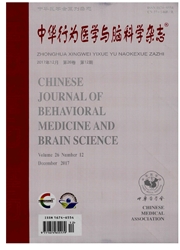

 中文摘要:
中文摘要:
目的探讨晨重夕轻抑郁症患者脑局部自发神经活动的能量特征。方法招募20例晨重夕轻抑郁症患者、20例非晨重夕轻抑郁症患者和20位性别、年龄及受教育年限均匹配的健康对照,进行3.0T静息态磁共振扫描。比较三组受试脑区低频振幅(amplitude of low frequency fluctuations,ALFF)值,在方差分析的基础上进行两独立样本t检验,使用Alphasim进行多重比较矫正,将差异脑区ALFF值与临床症状群严重程度进行相关分析。结果三组受试右海马旁回(MNI:18,-36,-9;K=136)、左顶下小叶(MNI:-54,-45,42;K=86)、左小脑脚(MNI:-48,-60,36;K=86)及右小脑脚(MNI:9,-78,-36;K=91)的ALFF值均差异有统计学意义(P〈0.05,Alphasim矫正)。与非晨重夕轻组相比,晨重夕轻组右海马旁回ALFF值升高。与健康对照组相比,晨重夕轻组右海马旁回、左顶下小叶ALFF值升高,左小脑脚1区、右小脑脚2区ALFF值降低;非晨重夕轻组左顶下小叶ALFF值升高,左小脑脚1区、双侧小脑脚2区ALFF值降低。相关分析未发现差异脑区ALFF值与临床症状群存在相关关系(P〉0.05)。结论抑郁症的晨重夕轻节律可能与海马旁回活动异常有关。
 英文摘要:
英文摘要:
Objective To explore the energy feature of the spontaneous neural activity in depressive patients with diurnal rhythm. Methods Twenty depressive patients with diurnal rhythm, 20 depressive pa- tients without diurnal rhythm and 20 gender-, age-, education-matched healthy controls were scanned with 3.0 T MRI Scanner. According to results of ANOVA, group-wise two sample t-test was completed. The correla- tion analysis were conducted between ALFF of significant difference brain regions and the score of Hamilton rating scale for depression. Results The brain regions showing significant differenees among three groups were located in the right parahippocampal gyrus( MNI: 18,-36,-9; K = 136) ,left parietal lobe (MNI:-54, -45,42 ; K = 86 ) , left cerebellum crus ( MNI : - 84, - 60,36 ; K = 86 ) and right cerebellum crus ( MNI : 9, -78,-36;K= 91 ) (P〈0.05 ,Alphasim correct). Compared with non-diurnal rhythm group ,the diurnal rhythm group showed significantly increased ALFF in the right parahippocampal gyrus. Compared with healthy group, the diurnal rhythm group showed significantly increased ALFF in right parahippoeampal gyrus,left pa- rietal lobe, and significantly decreased ALFF in left cerebellum crus 1 and right cerebellum crus 2. Compared with healthy group,the non-diurnal rhythm group showed significantly increased ALFF in left parietal lobe,and significantly decreased ALFF in left cerebellum crus 1 and bilateral cerebellum crns 2. No correlation be- tween ALFF of significant difference brain regions and clinical symptoms was found (P 〉 0. 05 ). Conclusion The diurnal rhythm observed in depression may be associated with aberrant activity of parahip- pocampal gyms.
 同期刊论文项目
同期刊论文项目
 同项目期刊论文
同项目期刊论文
 期刊信息
期刊信息
